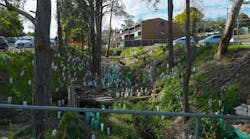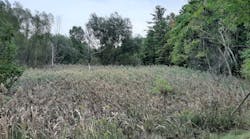Seeking the Very Big Picture
Sometimes seemingly far-fetched ideas have the greatest payoffs, and it’s no different in the field of erosion control. Although tried-and-true methods are the staple of most EC programs, it’s often useful to take a step back and look at the long-term effects of the phenomenon we’re trying to control. John Fuhrmann’s article in this issue (“Extragalactic Tools,” page 36) shows one way of doing that. The esoteric-sounding technique of accelerator mass spectrometry, which can be performed at only a few laboratories in the world, is helping to give us that long-term view of how erosion operates. Also used in fields as diverse as medicine (to study how the human body metabolizes certain drugs or toxins, for example) and archaeology (to date artifacts using a much smaller amount of organic material than radiocarbon dating requires), the technique can help illustrate erosion patterns throughout an entire watershed over several millennia. Of course, when you’re thinking in terms of project milestones or (as so many of us are these days) deadlines for NPDES permit compliance, your long-term view might consist of months, not millennia. But when you’re planning where to place a new development, or recommending farming or soil conservation practices, or deciding whether beach nourishment is a sensible strategy for your disappearing shore, it’s essential to have a bigger picture. The Texas General Land Office, for instance, keeps detailed historic records of erosion in the state’s major bays-maps showing how much land has been lost or gained, and where, and how fast. The GLO considers not only the climate changes during the last 18,000 years (progressively less rainfall means rivers are carrying less sediment seaward) but also small current events, such as the turbulence from ships’ wakes eating away at channels and shorelines. It’s not merely an academic exercise, but a vital planning tool in a state where people love to build on beachfront property and where, over the last several decades, oceanside parks and residential subdivisions have been swallowed up by the encroaching sea. Sophisticated tools can reveal ancient patterns still in the making. For example, core sediment sampling and ground-penetrating radar can show us the historic patterns of beach erosion and accretion, and they’re not always what we expect them to be. What we can observe in a lifetime might be only a fraction of the cycle. Slight climate changes or atypical weather patterns-droughts, frequent tropical storms, minute changes in sea level-can cause temporary variations in the pattern without significantly altering the larger picture.The long-term view is important for predicting what will happen not only in coastal regions but also in mountainous areas, as Fuhrmann’s article describes. What have we caused, and what would have occurred anyway with no human activity to spur it along? It now appears likely that some of Nepal’s farming practices are actually staving off the landslides that periodically devastate the region-just the opposite of what we had assumed. On the other hand, the same accelerator mass spectrometry technique applied in Sri Lanka reveals that farming practices there are causing erosion rates up to 100 times greater than those of undisturbed forest lands-far more than anyone imagined. Although it’s not a tool that will be available to everyone in the immediate future, this arcane technique reminds us of how important it can be to look backward before moving ahead.

